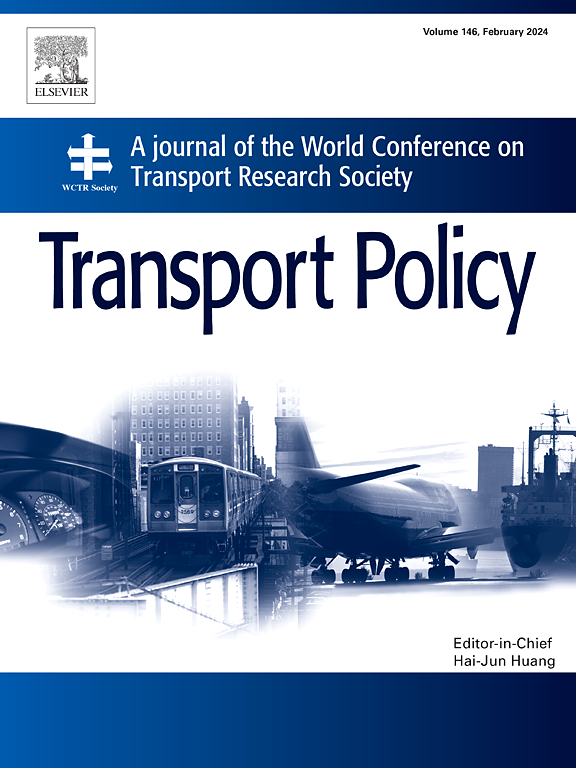Development impact of airport capacity expansion with city-airport expressway connection in Asia's emerging economies: Evidence on nighttime light intensity from Ha Noi
IF 6.3
2区 工程技术
Q1 ECONOMICS
引用次数: 0
Abstract
Major cities in Asia's emerging economies continue to deliver megaprojects for airport capacity expansion, including city-airport ground transportation connection, to meet growing air travel demand, support dynamic supply chain reconfiguration, and promote wider urban economic development. Nevertheless, there is little evidence about whether and how such megaprojects can transform cities for airport-linked development in Asia's emerging economies. This study examines the development impact of new terminal construction with city-aiport expressway connection projects by analyzing changes in nighttime light intensity (NTL) along the new ground transportation corridor in Ha Noi, Viet Nam. In this microgeographic impact analysis, NTL is assumed to indicate the degree of urban economic activity or development. A spatial-temporal dataset was organized on a 500-m grid-cell scale as the unit of analysis covering a 12-km distance buffer area from the new city-airport ground transportation corridor for 2012–2020. Based on a quasi-experimental design framework, difference-in-differences (DID) estimation techniques were applied to pursue causal inference. The results of the DID model analysis present that the impact of new terminal construction with city-airport expressway connection projects on NTL is significantly positive near the new ground transportation corridor. An additional analysis further reveals that the NTL impact tends to be greater near the city center, significant regardless of residential density, and significant in already well-developed locations. These empirical findings highlight the importance of city-airport expressway connection along with strategic land reform programs and land-use rezoning practices in distributing and amplifying the catalytic effects of airport capacity expansion citywide in Asia's emerging economies.
亚洲新兴经济体机场容量扩张与城市-机场高速公路连接的发展影响:来自河内的夜间光强度证据
亚洲新兴经济体的主要城市继续实施大型机场扩容项目,包括城市-机场地面交通连接,以满足日益增长的航空旅行需求,支持动态供应链重构,促进更广泛的城市经济发展。然而,几乎没有证据表明,这些大型项目是否以及如何能改变亚洲新兴经济体的城市,实现与机场相关的发展。本研究通过分析越南河内新地面交通走廊沿线夜间光强(NTL)的变化,考察了新航站楼建设与城市-机场高速公路连接项目的发展影响。在这种微观地理影响分析中,假定NTL表示城市经济活动或发展的程度。以2012-2020年新城空港地面交通走廊12公里缓冲区为分析单元,在500米网格尺度上组织时空数据集。基于准实验设计框架,采用差分估计技术进行因果推理。DID模型分析结果表明,在新建的地面交通走廊附近,新航站楼建设与城空高速连接项目对NTL的影响显著为正。另一项分析进一步表明,NTL的影响往往在市中心附近更大,与居住密度无关,在已经很发达的地区也很明显。这些实证研究结果强调了城市-机场高速公路连接以及战略性土地改革计划和土地利用重新分区实践在亚洲新兴经济体城市范围内分配和放大机场容量扩张的催化效应方面的重要性。
本文章由计算机程序翻译,如有差异,请以英文原文为准。
求助全文
约1分钟内获得全文
求助全文
来源期刊

Transport Policy
Multiple-
CiteScore
12.10
自引率
10.30%
发文量
282
期刊介绍:
Transport Policy is an international journal aimed at bridging the gap between theory and practice in transport. Its subject areas reflect the concerns of policymakers in government, industry, voluntary organisations and the public at large, providing independent, original and rigorous analysis to understand how policy decisions have been taken, monitor their effects, and suggest how they may be improved. The journal treats the transport sector comprehensively, and in the context of other sectors including energy, housing, industry and planning. All modes are covered: land, sea and air; road and rail; public and private; motorised and non-motorised; passenger and freight.
 求助内容:
求助内容: 应助结果提醒方式:
应助结果提醒方式:


